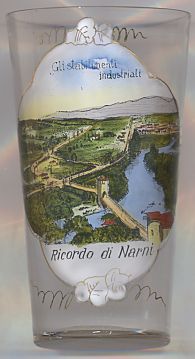

|
| ITALIA | ITALY |
| regione: Umbria | |
| provincia: Terni |
 Narni is situated at an elevation of 240 m above a narrow gauge of the Nera river in southern Umbria.
Narni has a population of about 20,200 (2004).
Narni is situated at an elevation of 240 m above a narrow gauge of the Nera river in southern Umbria.
Narni has a population of about 20,200 (2004).
Archaelogical finds in caves of the region demonstrate the presence of humans in Palaeolithic times. Around the start of the first millennium the Osco-Umbrian (Ombrikoì in Greek), a people of Indo-European origin that dominated the left bank of the Tiber river settled in the area and called the town Nequinum. Records mention Nequinum as early as 600 BC. The Romans conquered Nequinum in the 4th century BC and made it a position of force in this key point of the Via Flaminia, the famous road which connected the city of Rome with the Adriatic Sea. It supported the Gauls with the hope of freeing itself from Rome. In 299 BC it became a Roman municipality, and took the name Narnia as the former name was considered of ill augury (in Latin, 'nequeo' means "I am unable", and 'nequitia' means "worthlessness"). In 209 BC it was destroyed by the Romans for refusing to help pay for the war against Carthage. It was later rebuilt, and during the Roman times it was an outpost for the Roman army. In Late Antiquity it suffered the events of the Greek–Gothic War (535–554) and was the seat of a Lombard gastald.
From the 11th century it began to increase in wealth and power. In 1167 the town rose against Emperor Friedrich I
Barbarossa, which cost Narni a ferocious repression imposed by the archbishop Christian of Mainz, Barbarossa's Chancellor.
In 1242 Narni, prevalently tied to the Guelf party, entered into an alliance with Perugia and Rome against the Empire.
In the following century it was included in the reconquest of the papal patrimony. In the 15th century it was occupied by
Sicily but was soon again reabsorbed by the church. In 1525 the troops of Charles V put the city to fire and sword;
it lost its ancient prosperity. The reconstruction of the town gave it a physiognomy characteristic of the cities in the
Papal territory. Narni became part of the Roman Republic in 1789 and was annexed to the Italian Kingdom in 1860.
[http://en.wikipedia.org/wiki/Narni]
![[scale]](lineal.jpg)